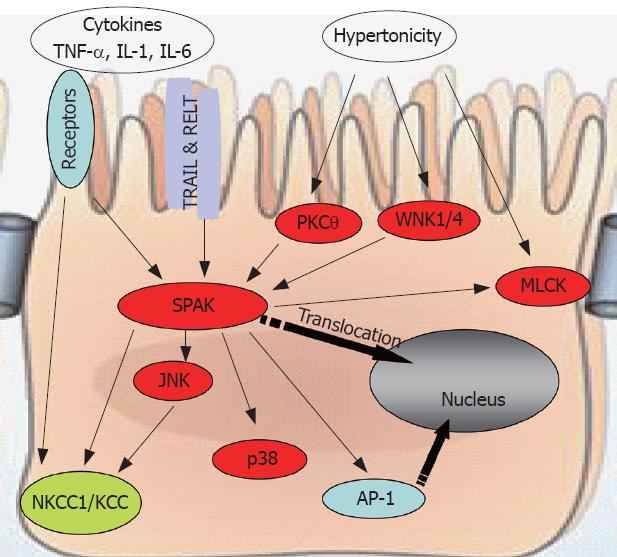Copyright
©2008 The WJG Press and Baishideng.
World J Gastroenterol. Oct 28, 2008; 14(40): 6115-6121
Published online Oct 28, 2008. doi: 10.3748/wjg.14.6115
Published online Oct 28, 2008. doi: 10.3748/wjg.14.6115
Figure 3 SPAK interacts with other molecules to maintain cellular homeostasis.
SPAK can be a substrate, indirectly or directly, for pro-inflammatory cytokines, environmental stress including hypertonicity, some other kinases such as PKCtheta;, WNK1/4, or other receptors, for example TRAIL & RELT. Also SPAK can function as upstream kinase to JNK, p38, or ion transport NKCC1/KCC, transcription factor AP-1, as well as MLCK. WNK: With no lysine kinase 1/4; TRIL: TNF-related apoptosis-inducing ligand; RELT: Receptor expressed in lymphoid tissues; MLCK: Myosin II regulatory light chain kinase; NKCC1: Sodium potassium chloride chloride transporter 1; KCC: Potassium chloride chloride transporter; AP-1: Activating protein 1.
- Citation: Yan Y, Merlin D. Ste20-related proline/alanine-rich kinase: A novel regulator of intestinal inflammation. World J Gastroenterol 2008; 14(40): 6115-6121
- URL: https://www.wjgnet.com/1007-9327/full/v14/i40/6115.htm
- DOI: https://dx.doi.org/10.3748/wjg.14.6115









